People's desire for peace and creating new relationships with nature: From Okinawa
25.01.2023
SUBMITTING ORGANIZATION
AEON Environmental Foundation
OTHER CONTRIBUTING ORGANIZATIONS
AEON Ryukyu Co., Ltd.
Institute for Global Environmental Strategies (IGES)
DATE OF SUBMISSION
11/01/2023
REGION
Asia
COUNTRY
Japan
KEYWORDS
World War II; Peace Memorial Park; Final waste disposal site; Red soil runoff; Home of the Okinawa rail
AUTHORS
Hideyuki Kubo, IGES
Mai Fukada, AEON Ryukyu Co., Ltd.
Summary Sheet
The summary sheet for this case study is available here.
1. Background
At the end of World War II, the Battle of Okinawa was fought between Allied and Japanese forces on the Okinawa islands. The Battle of Okinawa was a ground war directly involving the people of the prefecture, and 120,000 of the then population of approximately 490,000 were killed. Of these, 94,000 were civilian casualties. After the war, Okinawa was under the administration of the United States, and was not returned to Japan until 1972. Today, more than 75 years after the war, the bones of residents and soldiers remain buried in the ground in the mountains, in dugouts, and in the ruins of military positions on Okinawa, and U.S. military bases on the island remain.
The AEON Environmental Foundation is a solely corporate public interest foundation that works on the theme of the global environment, based on AEON’s basic philosophy of “pursuing peace, respecting people, and contributing to local communities, with the customer as the starting point.” Peace is placed first because the retail industry is a peace industry. Since the AEON group operates a retail business in Okinawa, group members must embody their own desire for peace in various ways. As part of its activities, the AEON Environmental Foundation is involved in creating a new relationship between the natural environment and human beings in order to lay the foundation for peace. Here four support activities are introduced. These are: tree planting at the Peace Memorial Park, tree planting at the former final waste disposal site in Naha, prevention of red soil runoff that destroys the sea, and forest conservation by the “Home of the Okinawa rail” in Yanbaru.
2. Tree planting at the Peace Memorial Park
2.1 A place to pray for and transmit peace
The Peace Memorial Park is located in Mabuni, Itoman City, in the southern part of Okinawa island (see Figure 1 and 2). This was the site of the last fierce battle of the Battle of Okinawa. The Ryukyuan government, established under U.S. administration, designated the area around Itoman, including the area of Mabuni, as the Okinawa Battle Site Government Park (Natural Park) in 1965. The purpose of this designation was to protect the battle sites in the southern part of the main island of Okinawa, the site of fierce fighting between Japan and the U.S. during the World War II, in order to recognize the tragedy of war and the sanctity of peace, to comfort the spirits of the more than 200,000 war dead, and to protect the magnificent landscape of sea cliffs. After the reversion of Okinawa to Japan, the Okinawa prefectural government has been fully developing the area as an urban park.
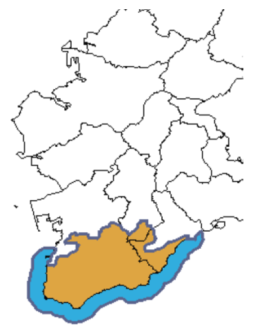
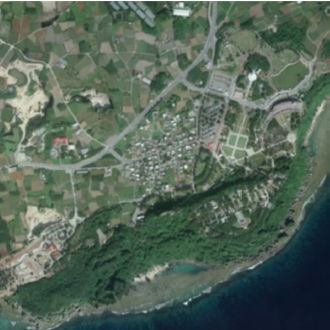
The park includes the Peace Memorial Museum, which displays photographs and artifacts from the Battle of Okinawa; the Peace Corner, where the names of all those who died in the Battle of Okinawa are engraved; the Okinawa Peace Memorial Hall, where a peace statue is enshrined to pray for the repose of the dead and eternal peace; the National Okinawa War Cemetery and prefectural and organizational cenotaphs; and others. The area is visited by tourists and memorial groups from Japan and abroad throughout the year, and on holidays, it is a place where families come to picnic and enjoy recreation.
2.2 Tree planting by the AEON Environmental Foundation
In 2017, a recreation zone was opened in the Peace Memorial Park, with walking paths for nature observation and a plaza for picnics, attracting many families. In December 2017, the AEON Environmental Foundation, in collaboration with the Okinawa prefectural government, Itoman City government, and the Okinawa Peace Memorial Foundation, held a tree-planting ceremony to create an AEON forest in the hope that the Peace Memorial Park would become even more familiar to people as a place with greenery and to renew their wish for peace. A total of 500 volunteers participated in the tree planting activities, planting a total of 5,300 seedlings. The seedlings were made up of 12 tropical local tree species.
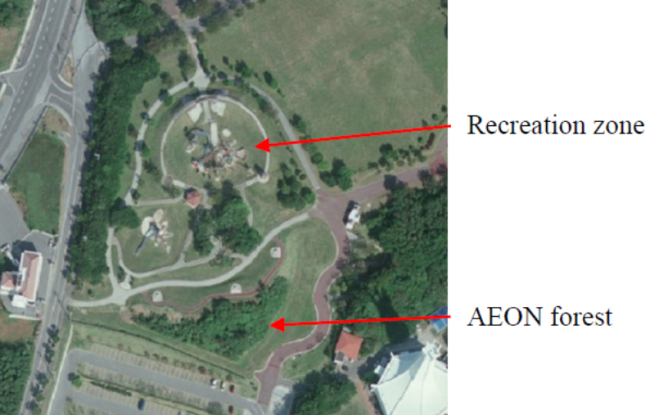
3. Tree planting at the former final waste disposal site in Naha
Adjacent to Naha City, the town of Haebaru was a burnt-out area ravaged by air raids and artillery fire by the U.S. military during the Battle of Okinawa. After the war, Naha City disposed of waste in various locations in and around the city. In 1966, the city secured a hillside site in the northern part of Haebaru and constructed a waste treatment facility and final disposal site. On the other hand, waste disposal in Haebaru had generally been done in-house by digging holes in gardens and fields and burying or burning the waste. In 1970, the town began collecting waste, and in 1975, began outsourcing waste disposal to Naha.
In 1990, it was decided to construct a new final disposal site for general waste on this hilly land, and two and a half years later, in 1993, refuse began to be brought in (see Figure 4). The landfill disposal was then completed in 2007.
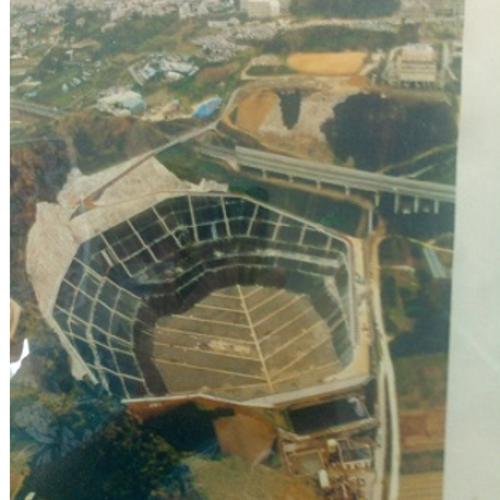
The reclaimed land was to be transformed into a multipurpose plaza for local residents, and a forest was to be created around the multipurpose plaza. AEON Ryukyu Co., Ltd. (then Ryukyu JUSCO Co., Ltd.) agreed to cooperate in the development of this forest, and together with the AEON Environmental Foundation, conducted tree planting activities for three years starting in 2007. More than 1,000 volunteers planted 10,000 seedlings each year, and a total of 3,500 volunteers planted 30,000 trees over the three years (see Figures 5 and 6). The trees planted included more than 20 species native to Okinawa, such as banyan trees and redwood trees. In 2012, the area was put to use as a multipurpose plaza (see Figures 7 and 8).
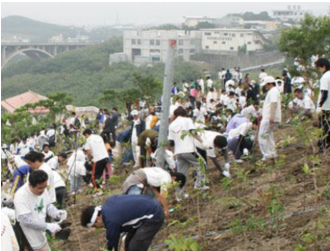
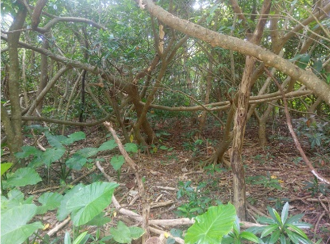
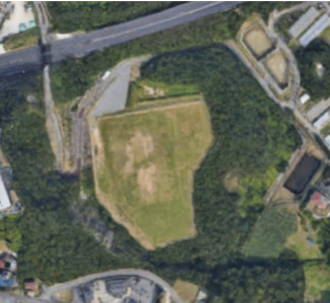

4. Prevention of red soil runoff that destroys the sea
4.1 Red soil runoff
In Okinawa, there are many fine-grained soils, known as red soil. Red soil flows into rivers and then into the ocean as rain falls and erodes the soil. Over time, the red clay that muddies the ocean sinks to the seafloor and is deposited, but the ebb and flow of the tide and waves cause it to rise up and muddy the ocean once again. The outflow of red clay becomes more pronounced when land is altered for agriculture and other development projects (see Figure 9 and 10). Agricultural land, development projects, and U.S. military bases account for by far the largest amount of red soil runoff, and are called the three major sources.
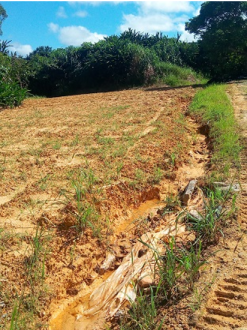
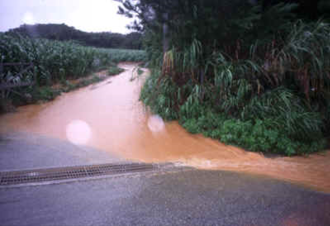
As red soil accumulates on coral reefs, corals become less able to photosynthesize and die (see Figure 11 and 12). Fish will also disappear as branching corals, the home of small sea creatures, disappear. The influx of red soil into the sea also degrades the seascape and affects marine sports and other tourism. The fisheries industry will also suffer from the disappearance of fish, and mozuku sea grass, a specialty of Okinawa, will also be affected.
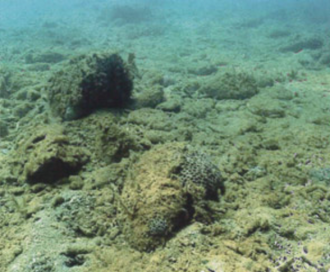
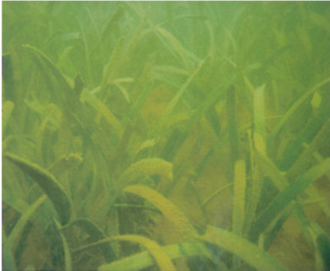
4.2 Prevention activities of red soil runoff
In an effort to solve the red soil problem, Okinawa Prefecture enacted the Red Soil and Other Runoff Prevention Ordinance (hereinafter referred to as the “Red Soil Ordinance”) in October 1995 to regulate the alteration of land due to development projects. As a result, a study of the degree of red soil accumulation from sand on the seafloor revealed that the average value for the period 1996-2002 was about 20% less than the average value for the period 1983-1995 for the prefecture as a whole.
Although red soil runoff from development projects has been controlled, soil runoff from farmland that has already been developed can still be seen throughout the prefecture. Various measures to prevent soil runoff from farmland have been devised and are being promoted by the prefectural and municipal governments, but only a few farmers are actively taking measures to prevent soil runoff because they do not lead to income for farmers. Table 1 shows specific examples of measures that have been taken to prevent red soil runoff from agricultural land.
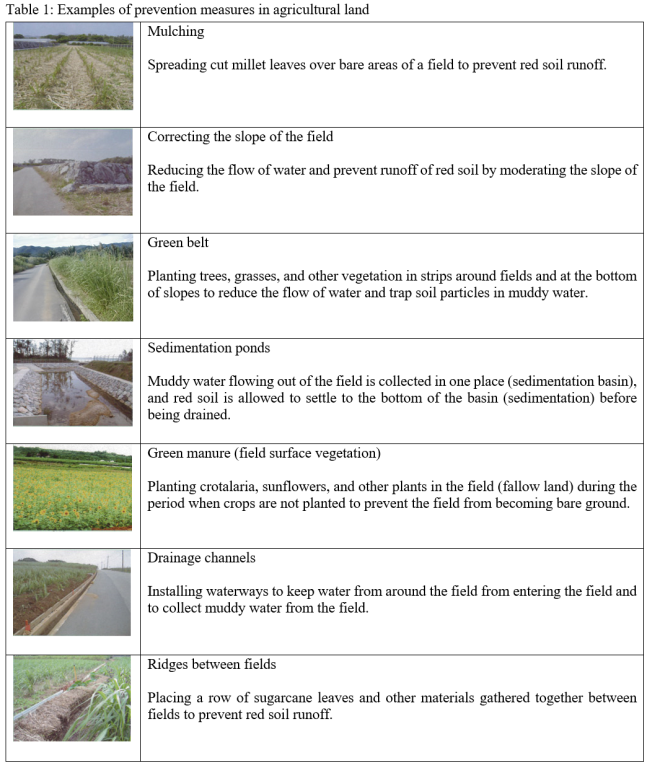
Among these runoff prevention measures, greenbelts are a relatively easy and effective method. According to past cases, greenbelts have been effective in reducing about 50-60% of red soil runoff.
4.3 New attempts by high school students
Major AEON group companies contribute an amount equivalent to 1% of their pretax profits to CSR activities. One such activity is the AEON Eco-1 Grand Prix. One of the activities awarded in FY2020 was the development and dissemination of a water collection system using traditional Japanese soil called “Tataki” by students of Nakui Agricultural High School in Aomori Prefecture. The students learned from a plasterer how to mix soil, sand, and slaked lime. Using this method, they were able to reduce soil runoff by approximately 90% in an experiment. The students of Nakui Agricultural High School, together with students from Hedona High School and Hokubu Agriculture and Forestry High School in Okinawa, began working together to prevent the runoff of red soil.
In late May 2022, with the support of the AEON Environmental Foundation, students from both prefectures held an exchange event in Higashi Village in the northern part of the main island of Okinawa. At the event, the students exchanged opinions on the prevention of red soil runoff, and also conducted an experiment in which they placed a fill of “Tataki” at the edge of an irrigation canal bordering a field in Higashi to prevent red soil runoff. In the future, the two parties will conduct a wide range of “Tataki” experiments in the fields and cooperate to verify the situation and effectiveness of these experiments.
5. Forest conservation by the “Home of the Okinawa rail” in Yanbaru
In Kunigami Village, located in the northern part of Okinawa’s main island, there is the Ada community, which was declared the “Home of the Okinawa rail” in 2012 (see Figure 13 and 14). Ada is a small community with a population of approximately 180 people, but it has played an important role in the process leading to the registration of “Amami-Oshima Island, Tokunoshima Island, Northern part of Okinawa Island, and Iriomote Island” as a Natural World Heritage site in July 2021.


5.1 Preventing live-fire exercises by the U.S. military
Ada was said to be an isolated community on land with no maintained roads until a few decades ago. People lived mainly on subsistence from natural resources, catching fish and shrimp in the sea and rivers and hunting wild boar in the mountains. Forestry was an important source of cash income.
On December 21, 1970, the U.S. Marine Corps notified the Forestry division of the Ryukyu government of a live-fire exercise nearby the Ada community in Kunigami Village. The plan was to set up a cannon gate on Mount Hashimata and fire live rounds toward the top of Mount Ibu. When the U.S. Marines notified the residents of Ada community on December 30 that the firing exercise would take place on December 31, the community held an emergency meeting and decided to hold an all-out action to stop the exercise. At 5:00 a.m. on the following day, the 31st, friends from all over the village gathered at the Ada community center. The number of people who gathered there reached 800. Young men headed for the summit of Mt. Ibu, where bombs would land, while the women, children, and elderly headed for Mount Hashimata, where they would set up artillery gates. Around 8:00 a.m., soldiers and artillery were brought into Mount Hashimata. Skirmishes began between residents and U.S. forces, resulting in one person being seriously injured and four people being arrested. The U.S. forces did not enforce the exercise, and at 11:15 a.m., the village head reported that the exercise had been canceled. The soldiers and artillery were then removed, and the Marine Corps commander officially announced the cancellation of the exercise later that day.
Thanks to the strong solidarity of the residents of Ada community, the live-fire exercise was cancelled and the nature that sustains people’s lives was protected. This action led to the registration of the area as a Natural World Heritage site and a series of efforts to protect living organisms half a century later.
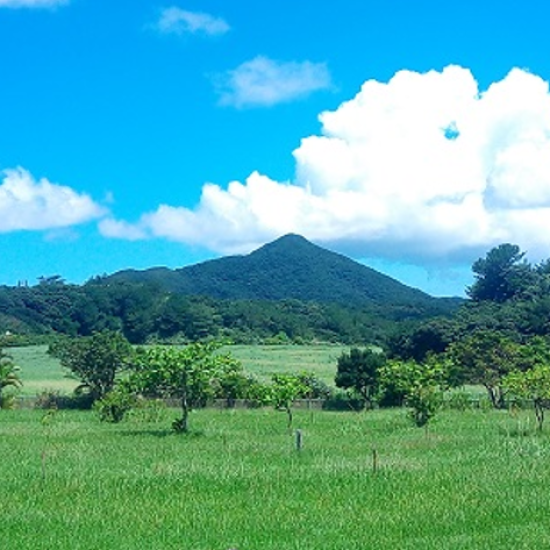
5.2 Protection activities for Okinawa rail
In 1981, a bird captured in Kunigami Village was named as a new species of Okinawa rail. The 1985 survey estimated that there were about 1,800 Okinawa rail in the area, but by 2005 the number had decreased to about 700. The main cause of this decline due to predators such as the mongoose, which was introduced from India to southern Okinawa island as a measure against the Okinawa habu, a venomous snake. The mongoose also began to invade the Yanbaru forests in the northern part of the island in the 1990s.
Ada area is home to a large number of Okinawa rail species, especially in the Yanbaru forest. Since around 2001, the residents of Ada community have been involved in nature conservation activities centering on the Yanbaru rail, in efforts to revitalize the community through these activities. The first attempt was the establishment of cat-keeping regulations in 2002 to prevent the impact from cats as predators. In the same year, an environmental conservation fund was established. With this fund, Ada community established an NPO called Yanbaru Community Revitalization Support Center in 2009. Meanwhile, Kunigami Village, at the initiative of its mayor, decided in 2006 to establish a shelter for the protection of the Okinawa rail in Ada. To prevent the impact from predators such as the mongoose and feral cats, an area of approximately 13 hectares was enclosed by a 2.7 meter-high fence. The work of putting up the nets was done by volunteers, including village residents. In 2010, the Ministry of the Environment, Japan established a “Breeding facility for Okinawa rail” in Ada. In 2012, Ada community declared itself the “Home of the Okinawa rail.”
The following year, in 2013, Kunigami established an ecology exhibition and learning facility for the Okinawa rail in the Okinawa rail park in Ada, where the birds can be observed in their natural habitat. The purpose of this facility is to spread awareness about wildlife protection and conservation of the natural environment through observation of the Okinawa rail. Only one Okinawa rail is kept in the observation booth, where visitors can see the bird in a recreation of its natural habitat. The bird is very curious, and friendly, as it was raised in captivity.
5.3 Balance between biodiversity conservation and its use for tourism
Yanbaru forest is an ecosystem rich in biodiversity, home to many rare endemic and endangered species. Upon the declaration as the “Home of the Okinawa rail” in 2012, Ada community began work on the development of a basic concept and plan as the home of the Okinawa rail and published a report in 2013. In the process, members of a planning team visited Kumamoto Prefecture, accompanied by the mayor of Kunigami Village, to observe local revitalization efforts in each municipality. At that time, the governor of Kumamoto stated, “We created our bear mascot, Kumamon, (which has become very famous throughout Japan) because Kumamoto had nothing special to promote. Yanbaru has the wonderful bird of the Okinawa rail, so why don’t you use it to get the area registered as a Natural World Heritage site?”
In Ada community, this triggered a surge of momentum to register the Yanbaru forest as a Natural World Heritage site, turn it into a tourism resource, and attract people to the area to help drive the economy. On the occasion of a site visit by the International Union for Conservation of Nature (IUCN), IUCN experts visited the ecology exhibition and learning facility for Okinawa rail in Ada and had an opportunity to learn about the efforts of Ada community. In March 2021, the “Kitaro concert in Yanbaru” was held at the Okinawa rail park in Ada. Kitaro is an internationally recognized composer and musician. The concert was simultaneously livestreamed to the world online and was a great success. Furthermore, with the support of the AEON Environmental Foundation, 200 cherry tree seedlings were planted in the Okinawa rail park, making the park widely known as the earliest cherry blossom viewing spot in Japan (see Figures 16 and 17).
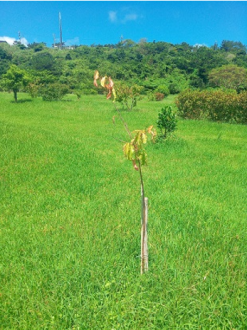

A World Heritage site will be removed from the list if it fails to maintain its value after registration. For this reason, the three villages in the Yanbaru forest (Kunigami, Ogimi, and Higashi) plan to create a fund to boost regional development and education. Specifically, they are taking on the challenge of building infrastructure for high-speed communication functions, switching to electric vehicles and buses for intra-regional transportation, promoting adventure tourism with high-value-added content, setting up a World Heritage student exchange program, and developing the sixth industrialization of local industries, all of which are in line with emerging concepts under the new era.
6. Looking to the future
In Okinawa, it is difficult for people to develop a new relationship with nature without coming into contact with the scars of the Battle of Okinawa. In the four case studies presented here, it can be seen that all were directly affected by the war, although the ways in which they interacted with nature differed.
The Peace Memorial Park is the last fierce battle site of the Battle of Okinawa, a place to recognize the tragedy of war and the sanctity of peace, and to remember the souls of the more than 200,000 war dead who died in the Battle of Okinawa. The creation of a forest there is intended to renew the wish for peace. The former site of the final disposal site in Haebaru town was burned to the ground in the Battle of Okinawa, ravaged by air raids and artillery fire by the U.S. military. The project seeks to use the area as a final waste disposal site and to surround it with greenery when it is reused as a multi-purpose plaza, a place that shows the steady progress made in the reconstruction of the war-ravaged land. The prevention of red soil runoff is a problem that occurs throughout Okinawa, but the U.S. military base is one of the three major sources of runoff, and it is a place where the consequences of the defeat in the Battle of Okinawa are still being felt to this day. Yanbaru forests have been protected from destruction to this day by the people of Ada community and Kunigami Village, who protested half a century ago against live-fire exercises by the U.S. military. This is a proof that the local people protected their lives and livelihood even under the U.S. administration.
On the other hand, attempts to create a new relationship between nature and people also show us directions that we have not seen before. Tree planting at the Peace Memorial Park has created opportunities for people to become familiar with greenery while praying for the souls of the war dead. The greening of the former landfill site and its use as a multi-purpose plaza shows that a community can be reborn through the activities of its people. The activities of high school students in the prevention of red soil runoff demonstrate that young people should play a leading role in the new era. And the balancing of biodiversity conservation and tourism in Ada community demonstrates that it is ahead of its time in using cutting-edge technology to solve global issues. The creation of a new relationship between nature and people in Okinawa is inseparable from the pursuit of peace, and is steadily ushering in a new era.
Acknowledgements
We thank Mr. Akio Higa, Mr. Takashi Nishihara, Mr. Mitsuru Matsukawa, Mr. Yasukazu Kawamoto, Mr. Yoneo Nakada, Mr. Hajime Nakada, Mr. Daisaku Kobayashi, Mr. You Shimabukuro and Mr. Shouichirou Mekaru for their generous cooperation to our study. We also thank the AEON Environmental Foundation for its support in conducting the survey.
References
Digital National Land Information (Ministry of Land, Infrastructure, Transport and Tourism, Japan). https://nlftp.mlit.go.jp/ksj/index.html. Downloaded on 27 August 2022.
Okinawa Green Network (2022) About red soil runoff. http://okinawagreen.net/akatsuchi/index.html. Downloaded on 27 August 2022.
The government of Okinawa Prefecture (2022a) Okinawa senseki kokutei-koen. https://www.pref.okinawa.jp/site/kankyo/shizen/koen/okinawa_sennseki_kokuteikouen.html. Accessed on 27 August 2022.
The government of Okinawa Prefecture (2022b) A story of red soil runoff. https://www.pref.okinawa.lg.jp/site/hoken/eiken/kankyo/mizu_hp/akatsuchiosennohanashi.html. Accessed on 27 August 2022.
The government of Okinawa Prefecture (2009) Red soil runoff in Okinawa Prefecture – Guidebook for red soil runoff -. Environmental Conservation Division, The government of Okinawa Prefecture. Downloaded from the website of Okinawa Green Network http://okinawagreen.net/akatsuchi/index.html on 27 August 2022.

